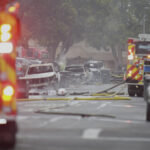The nation needs new solutions to improve the safety of natural gas pipelines coursing beneath neighborhoods, federal investigators said last Thursday as a three-day hearing on last year’s deadly blast in a San Francisco suburb drew to a close.
Dozens of industry officials, regulators and safety advocates testified before the National Transportation Safety Board as part of the hearing, which examined what led to the September explosion that killed eight people and destroyed dozens of homes in San Bruno.
Chairwoman Deborah Hersman said the accident highlighted a pattern of recurring safety problems and said the regulations guiding the industry may require reforms.
“There aren’t any new problems, what we need is new solutions,” she said. “Many of these issues are fields that have been plowed before.”
The network of natural gas lines includes many decades-old pipes that are not subject to a higher level of inspections or safety standards, Hersman said.
The large, high-pressure transmission pipeline that burst in California last fall was installed in 1956. An NTSB examination after the accident revealed it had a seam and inferior welds. Pacific Gas & Electric Co. records had inaccurately identified the pipe as being seamless, which is considered to be safer.
The line also was not equipped with remotely operated or automatic shut-off valves, which would have halted the gas flow within minutes of the accident and lessened the force of the blaze engulfing the subdivision. Instead, it took utility crews nearly an hour and a half to reach the line’s manual valves to shut off the gas.
PG&E spokesman Joe Molica said the company plans to install automatic shut-off or remotely controlled valves on several transmission lines running between Milpitas and San Francisco, as part of a pilot program this year.
Molica estimated each valve would cost between $100,000 to $1.5 million.
Was this article valuable?
Here are more articles you may enjoy.

 Delivery Hero Hit by $376 Million Fine for Glovo Cartel
Delivery Hero Hit by $376 Million Fine for Glovo Cartel  Four Ex-VW Managers Convicted in Germany Over Diesel Scandal
Four Ex-VW Managers Convicted in Germany Over Diesel Scandal  Will Workers’ Comp Benefit from ‘Most-Favored-Nation’ Drug Pricing?
Will Workers’ Comp Benefit from ‘Most-Favored-Nation’ Drug Pricing?  Plane Crashes into San Diego Neighborhood, Setting Homes And Vehicles on Fire
Plane Crashes into San Diego Neighborhood, Setting Homes And Vehicles on Fire 